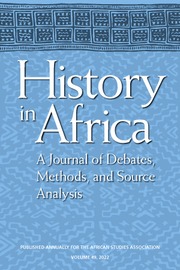| CARVIEW |
- Home
- >Journals
- >History in Africa
- >Volume 32
- >Bound to Africa: the Mandinka Legacy in the New World
- English
- Français
Article contents
Bound to Africa: the Mandinka Legacy in the New World
Published online by Cambridge University Press: 09 May 2014
Extract
I offer here a theory of “cultural convergence,” as a corollary to Darwin's natural selection, regarding how slave Creoles and culture were formed among the Gullah and, by extension, supported by other examples, in the Americas. When numerous speakers from different, and sometimes related, ethnic groups have words with similar sounds and evoke related meanings, this commonality powers the word into Creole use, especially if there is commonality with Southern English or the host language. This theory applies to cultural features as well, including music. Perhaps the most haunting example of my theory is that of “massa,” the alleged mispronunciation by Southern slaves of “master.” Massa is in fact the correct Bainouk and Cassanga ethnic group pronunciation of mansa, the famous word used so widely among the adjacent and dominant Mande peoples in northern and coastal west Africa to denote king or boss. In this new framework, the changes wrought by Mandinka, the Mande more broadly, and African culture generally on the South, are every bit as significant as the linguistic infusions of the Norman Conquest into what became English.
Information
- Type
- Research Article
- Information
- Copyright
- Copyright © African Studies Association 2005
Access options
Get access to the full version of this content by using one of the access options below. (Log in options will check for institutional or personal access. Content may require purchase if you do not have access.)Article purchase
Temporarily unavailable
References
- 3
- Cited by
Cited by
Loading...
Save article to Kindle
To send this article to your Kindle, first ensure no-reply@cambridge.org is added to your Approved Personal Document E-mail List under your Personal Document Settings on the Manage Your Content and Devices page of your Amazon account. Then enter the ‘name’ part of your Kindle email address below. Find out more about sending to your Kindle. Find out more about saving to your Kindle.
Note you can select to save to either the @free.kindle.com or @kindle.com variations. ‘@free.kindle.com’ emails are free but can only be saved to your device when it is connected to wi-fi. ‘@kindle.com’ emails can be delivered even when you are not connected to wi-fi, but note that service fees apply.
Find out more about the Kindle Personal Document Service.
- Volume 32
- Matt Schaffer
- DOI: https://doi.org/10.1353/hia.2005.0021
Save article to Dropbox
To save this article to your Dropbox account, please select one or more formats and confirm that you agree to abide by our usage policies. If this is the first time you used this feature, you will be asked to authorise Cambridge Core to connect with your Dropbox account. Find out more about saving content to Dropbox.
- Volume 32
- Matt Schaffer
- DOI: https://doi.org/10.1353/hia.2005.0021
Save article to Google Drive
To save this article to your Google Drive account, please select one or more formats and confirm that you agree to abide by our usage policies. If this is the first time you used this feature, you will be asked to authorise Cambridge Core to connect with your Google Drive account. Find out more about saving content to Google Drive.
- Volume 32
- Matt Schaffer
- DOI: https://doi.org/10.1353/hia.2005.0021


